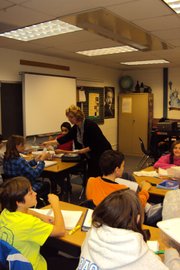History and social studies teacher John Perriello prepares a video presentation for the students before the re-enactment activity. Perriello informs students of the harsh reality experienced by factory workers.
Simulating History
“The idea of any simulation is to give the students an emotional experience on which we can then connect the content knowledge to develop true understanding of historic events.”
-- Susan Reade
Students experienced a blast to the past when they took part in historical simulations of factory work in the 1900s. On Monday, Oct. 21, seventh graders at Robinson Secondary School engaged in an activity created by their history and social studies teachers reflecting their studies of the Industrial Revolution. “The idea of any simulation is to give the students an emotional experience on which we can then connect the content knowledge to develop true understanding of historic events,” says Susan Reade, history and social studies teacher at Robinson Secondary. “For this specific event … we attempt to focus student attention on low pay, long hours doing a repetitive task, and dehumanizing treatment of the employees.”
At the onset, students were chosen to play the roles of factory supervisors, workers, merchandisers or individuals hoping to be hired. The latter group waited on one side of the lecture hall while the workers, supervisors and merchandisers situated themselves around tables topped with paper-car parts waiting to be cut and transformed into paper cars. Each individual worker would experience the monotony of repetitive, assembly-line work. While simulating the assembly-line work, students were also meant to experience the pressure of working fast and efficiently in order to prevent being fired and replaced by a worker waiting to be hired, on the other side of the hall.
In addition to supervising and orchestrating the event, the social studies teachers acted as factory foremen. They scolded and reprimanded the workers in order to provide a more authentic experience and to convey the pressure on the workers to perform, and to perform well or otherwise be fired. Before the activity history and social studies teacher John Perriello explained to the students that they were to consider the pressure of being a factory worker who needed to keep the job in order to support their family, despite emotional abuse, little regard for their welfare, and overall grueling conditions.
Simulations are a “labor of love because of the time and man power required to run one of [them],” says Reade. According to Reade, the simulations take place twice every quarter of the school year. The simulations are integrated into lesson plans and correspond to Fairfax County curriculum; they offer an interactive way of learning and engaging with history. While students did not dress up for this simulation, they will for the next one, which is scheduled to take place in early November. The next event will be related to the study of Ellis Island.



